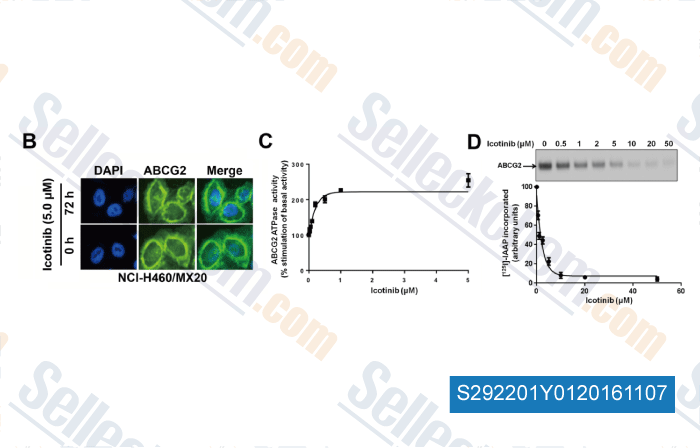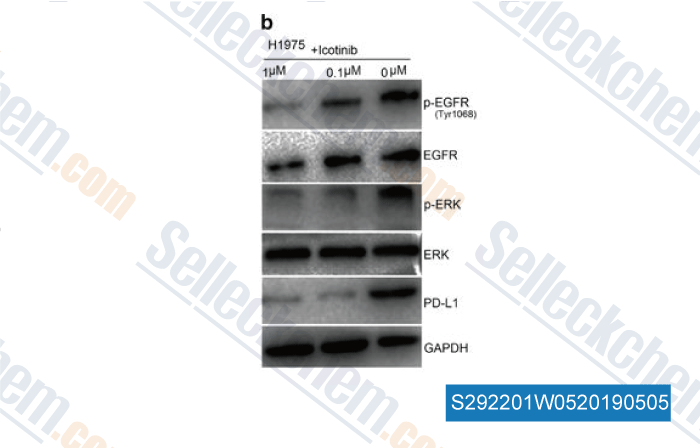|
Toll Free: (877) 796-6397 -- USA and Canada only -- |
Fax: +1-832-582-8590 Orders: +1-832-582-8158 |
Tech Support: +1-832-582-8158 Ext:3 Please provide your Order Number in the email. |
Technical Data
| Formula |
C22H21N3O4
|
|||
| Molecular Weight | 391.42 | CAS No. | 610798-31-7 | |
| Solubility (25°C)* | In vitro | DMSO | 78 mg/mL (199.27 mM) | |
| Ethanol | 6 mg/mL (15.32 mM) | |||
| Water | Insoluble | |||
|
* <1 mg/ml means slightly soluble or insoluble. * Please note that Selleck tests the solubility of all compounds in-house, and the actual solubility may differ slightly from published values. This is normal and is due to slight batch-to-batch variations. * Room temperature shipping (Stability testing shows this product can be shipped without any cooling measures.) |
||||
Preparing Stock Solutions
Biological Activity
| Description | Icotinib (BPI-2009H) is a potent and specific EGFR inhibitor with IC50 of 5 nM, including the EGFR, EGFR(L858R), EGFR(L861Q), EGFR(T790M) and EGFR(T790M, L858R). | ||
|---|---|---|---|
| Targets |
|
||
| In vitro | Icotinib inhibits EGFR activity in a dose-dependent manner, with an IC50 value of 5 nM and complete inhibition at 62.5 nM. Icotinib selectively solely inhibits the EGFR members including the wild type and mutants with inhibition efficacies of 61-99%. Icotinib blocks EGFR-mediated intracellular tyrosine phosphorylation in human epidermoid carcinoma A431 cells in a dose-dependent manner. Meanwhile, in our proliferation assay performed on A431, BGC-823, A549, H460, HCT8, KB and Bel-7402 cell lines, we found that the relative sensitivity of cell lines to Icotinib is A431 > BGC-823 > A549 > H460 > KB > HCT8 and Bel-7402. Icotinib exhibits a broad spectrum of antitumor activity and it is especially effective against tumors expressing higher levels of EGFR. [1] | ||
| In vivo | Icotinib shows an antitumor effect in different types of xenografts. Icotinib inhibits tumor growth at a rate of 51.5%, 31.0% and 67.4% in the A431, A549 and H460 xenografts at a dose of 120 mg/kg, respectively. [1] |
Protocol (from reference)
| Kinase Assay:[1] |
|
|---|---|
| Cell Assay:[1] |
|
| Animal Study:[1] |
|
Customer Product Validation

-
, , Oncotarget, 2015, 5(12):4529-42.

-
Data from [Data independently produced by , , Oncogene, 2017, 36(45):6235-6243]
Selleck's Icotinib (BPI-2009H) has been cited by 9 publications
| Genetic alterations predict poor efficacy, outcomes and resistance to second-line osimertinib treatment in non-small cell lung cancer [ Am J Cancer Res, 2024, 14(1):33-51] | PubMed: 38323283 |
| A community challenge for a pancancer drug mechanism of action inference from perturbational profile data [ Cell Rep Med, 2022, 3(1):100492] | PubMed: 35106508 |
| Defining the sensitivity landscape of EGFR variants to tyrosine kinase inhibitors [ Transl Res, 2022, S1931-5244(22)00244-4] | PubMed: 36347492 |
| Sensitivity analysis of EGFR L861Q mutation to six tyrosine kinase inhibitors [ Clin Transl Oncol, 2022, 10.1007/s12094-022-02854-3] | PubMed: 35666454 |
| A positive feedback loop formed by NGFR and FOXP3 contributes to the resistance of non-small cell lung cancer to icotinib [ Transl Cancer Res, 2020, 9(2):1044-1052] | PubMed: 35117449 |
| HER2 recruits AKT1 to disrupt STING signalling and suppress antiviral defence and antitumour immunity. [ Nat Cell Biol, 2019, 21(8):1027-1040] | PubMed: 31332347 |
| BIN1 reverses PD-L1-mediated immune escape by inactivating the c-MYC and EGFR/MAPK signaling pathways in non-small cell lung cancer [Wang J Oncogene, 2017, 36(45):6235-6243] | PubMed: 28714960 |
| CD166-mediated epidermal growth factor receptor phosphorylation promotes the growth of oral squamous cell carcinoma [Guodong Jia, et al. Oral Oncology, 2016, 10.1016/j.oraloncology.2016.05.010] | |
| Icotinib antagonizes ABCG2-mediated multidrug resistance, but not the pemetrexed resistance mediated by thymidylate synthase and ABCG2. [Wang DS, et al. Oncotarget, 2015, 5(12):4529-42] | PubMed: 24980828 |
RETURN POLICY
Selleck Chemical’s Unconditional Return Policy ensures a smooth online shopping experience for our customers. If you are in any way unsatisfied with your purchase, you may return any item(s) within 7 days of receiving it. In the event of product quality issues, either protocol related or product related problems, you may return any item(s) within 365 days from the original purchase date. Please follow the instructions below when returning products.
SHIPPING AND STORAGE
Selleck products are transported at room temperature. If you receive the product at room temperature, please rest assured, the Selleck Quality Inspection Department has conducted experiments to verify that the normal temperature placement of one month will not affect the biological activity of powder products. After collecting, please store the product according to the requirements described in the datasheet. Most Selleck products are stable under the recommended conditions.
NOT FOR HUMAN, VETERINARY DIAGNOSTIC OR THERAPEUTIC USE.
